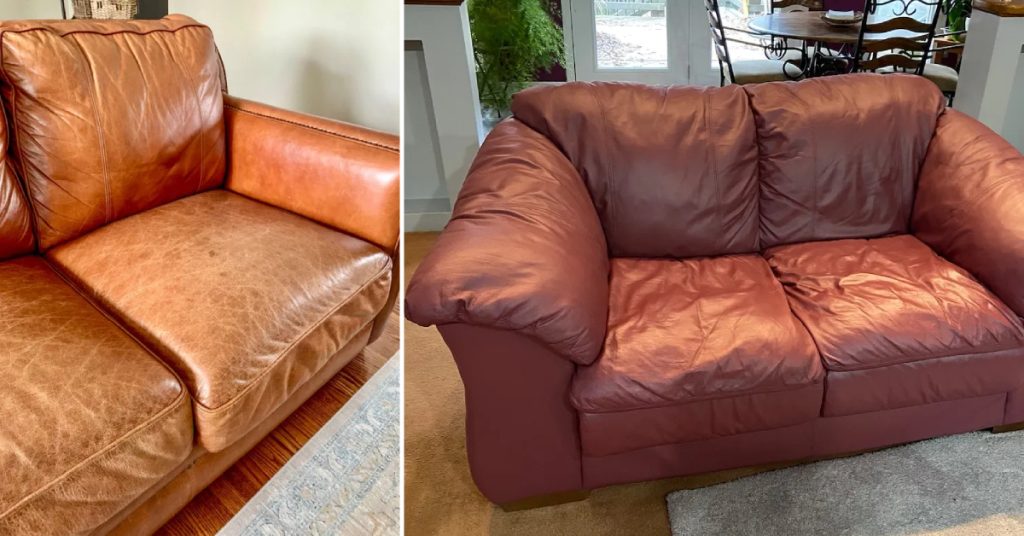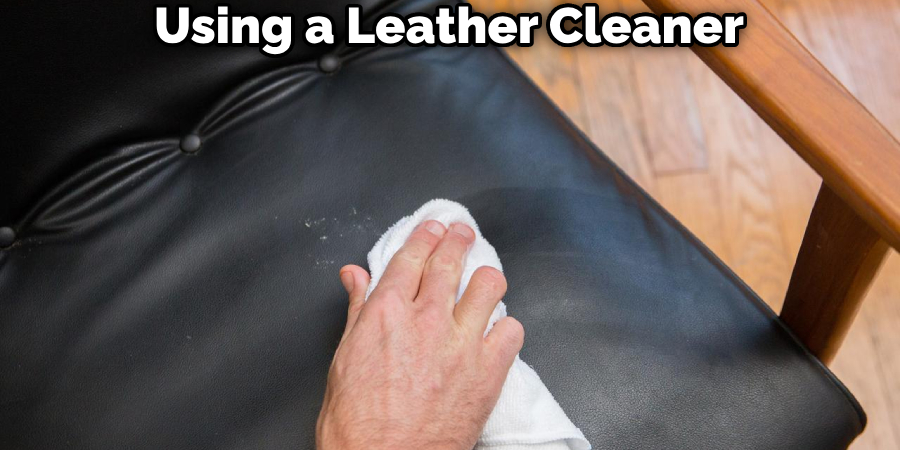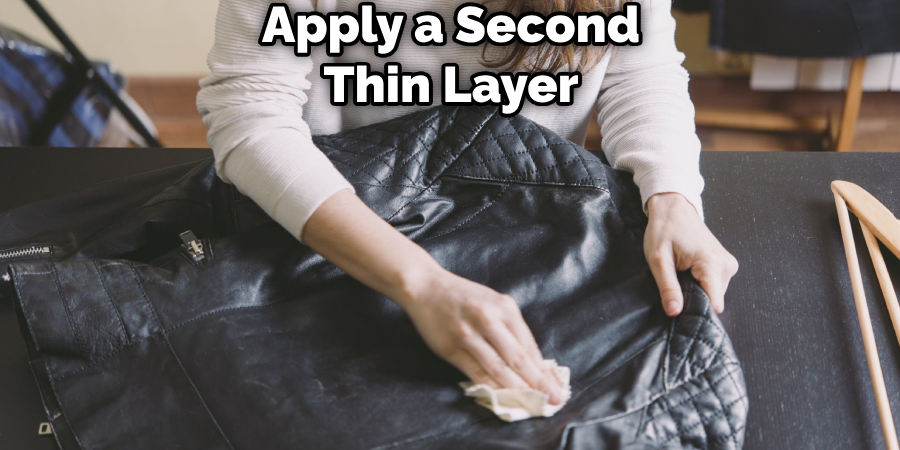Leather furniture often lasts for years. But over time, leather chairs and sofas can become faded, scratched, and generally look worn. Often the frame and cushions are still in great shape – it’s just the leather that needs some love. That’s where staining comes in handy for giving new life to your leather chair! Staining allows you to transform the color of the leather to achieve a rich, uniform appearance. With some supplies, preparation, and technique, you can make a worn leather chair look brand new again with a vibrant stain. This complete guide on how to stain a leather chair takes you through the entire process step-by-step.

Key Takeaway:
- Staining leather chairs renews color, hides imperfections, restores finish, at a fraction of reupholstery cost.
- Proper preparation through cleaning and sanding allows stain to properly bond.
- Apply quality leather stain in thin layers, testing first. Let dry fully between coats.
- Finish with a sealant topcoat to lock in vibrancy and durability.
- With the right materials and methodical technique, anyone can revitalize leather.
Why Stain a Leather Chair?
Here are the main reasons for using stain on an old leather chair:
- Change the Color: Stain allows you to transform a leather surface into pretty much any color you’d like. You can go brighter to match a room decor change or go darker for a more modern look.
- Hide Wear and Scratches: As leather ages, it can get scratched, fade spots, and look generally worn. The stain makes those imperfections recede so the chair looks flawless.
- Renew Finishes: When the stain is sealed properly, the finish protects the leather from further wearing for years.
- Less Costly Than Reupholstery: Staining refreshes the chair at a fraction of the price of complete reupholstery.
6 Effective Steps for How to Stain a Leather Chair
Here are the 6 effective steps for how to stain a leather chair:
Supplies Needed
Gather these supplies before starting your staining project:
- Leather cleaner
- Fine grit sandpaper
- Sponge applicators
- Lint-free cloths
- Selected leather stain
- Leather sealant
- Disposable gloves and cloths
Make sure the Quality leather stain formula is specifically for use on leather furniture to ensure compatibility and effective coloring.
Step 1. Clean the Leather
The first step in preparing any surface for stain is to clean it thoroughly. This means using a leather cleaner to remove built-up dirt, body oils, dust, and other contaminants. Pay special attention to the areas that see the most wear – armrests, edges, and crevices. Let the leather dry fully after cleaning before sanding.

Step 2. Lightly Sand Surface
Take fine-grit sandpaper (at least 280-320 grit) and gently rub it over all surfaces to be stained. This sanding serves to degloss the existing finish so the stain can properly bond. Make sure to smooth over any texture from sanding with a cloth before proceeding.
Step 3. Test Stain on Inconspicuous Area
Never apply stain straight to your leather chair surface without testing first! Leather can absorb stains differently depending on age, condition, and inherent properties. Apply a dime-sized amount of your chosen stain color in an inconspicuous spot first. If the tested stain is too light, opaque, or shows other flaws, adjust accordingly until you’re satisfied with the test stain result.
Step 4. Apply First Coat of Stain
Using a clean sponge applicator or lint-free cloth, apply the first thin coat of leather stain. Apply the stain slowly using circular, overlapping motions to coat the entire chair’s surface evenly. Work in small sections.
Tip: Always apply stain moving “with the grain” of the leather surface to prevent blotchiness.
Step 5. Allow Stain to Dry & Repeat
Per manufacturer instructions, allow the full drying time between coats (usually at least 12 hours). Then inspect the first coat coverage and apply a second thin layer, repeating until the stain provides your desired color intensity. Adding multiple sheer coats prevents the leather stain from becoming too saturated. 3 thin coats are generally sufficient.

Step 6. Apply Protective Sealant
Once the stain has fully dried, the final step is applying a protective leather sealant, which acts as a topcoat. This seals in the stain color and provides a barrier against moisture and wearing for long-lasting durability of your “new” chair!
After allowing full drying time for the sealant, your stained leather chair revamp is complete. With some careful prep and technique, you can fall in love with that leather chair all over again. Enjoy!
You Can Check It Out to Remove Scratches From Leather Chair.
FAQs About How to Stain a Leather Chair
Does Leather Permanently Stain?
While leather can absorb stains, prompt identification and treatment means most are not permanent. Water and dirt stains often wipe clean with the right leather cleaner, especially if conditioned regularly. More penetrating oil and grease stains may still be reversible if swiftly tended to. However, left too long without extraction, stains can permanently discolor and damage leather. The permanence generally depends on stain type, leather quality, and timeliness of cleaning. With quick action, what first appears as a stubborn stain can typically be removed before becoming an enduring scar. So long as the appropriate restoration measures are taken immediately, leather tends not to stain in perpetuity.
What is the Best Way to Stain Leather?
The key to effectively staining leather involves proper preparation, using quality materials, and applying stains in sheer layers. First, clean and lightly sand the leather so it readily absorbs the dye. Next, test high-grade leather stains to identify the ideal shade. Then, patiently apply thin, even coats with a soft cloth, allowing ample drying time between each application. Slowly building transparent layers creates rich color depth. Finally, seal the stain with a protective finish to lock in vibrancy and guard against wear. When done methodically with the right products, stained leather will display beautiful, durable color for years.
What Kind of Stain Do You Use on Leather?
When it comes to staining your favorite leather jacket or furniture, specialized leather stains are a clear choice. Unlike wood stains, leather stains are crafted to bring out the best in hide – enhancing the natural beauty while protecting its durable nature. Oil-based formulas allow the texture to shine through while providing a perfect infusion of color. For more drama, leather dyes drench pieces in striking hues from sky blue to crimson red. With quality leather stains and dyes made for the material, even beginners can stylishly revitalize leather goods with vivid and resilient colors that hold strong for years. Stick to the stains built for leather, and prepare for stunning results.
You Can Check It Out to Get Oil Out of Leather Chair.
Conclusion
Staining a well-loved leather chair can seem daunting, but this complete guide breaks the process into approachable steps. With some prep work, patience, high-quality materials, and proper technique, you can change the look of leather entirely. The finished product will have rich, transformative color and renewed protection against everyday wearing. Your once-worn-in chair will look and feel rejuvenated.
While staining leather yourself requires attentive care, the payoff is fulfilling your vision without the steep price tag of reupholstery. With these guiding steps, you can stain leather fearlessly. Before long, you’ll have a stunning centerpiece leather chair customized to your unique taste.


